Clash of Titans
Games featuring a future Hall of Fame coach on each sideline.
January 1,1941: Sugar Bowl - Tennessee vs Boston College
Robert Neyland vs Frank Leahy
When Frank Leahy was hired as Boston College coach for the 1939 season, replacing Gil Dobie, a headline in the Boston American blared: "UNKNOWN LEAHY SIGNED BY BOSTON COLLEGE"
30-year-old Leahy told the members of the University Club, including the players of his new team, "I have come to Boston College to succeed and not to fail." A tackle on Knute Rockne's Notre Dame teams of 1928-30, Leahy was an attentive student of the Rockne style of coaching. He honed his skill as line coach at Georgetown, Michigan State, and Fordham.
Leahy had high expectations for his 1940 Boston College team after the '39 squad went 9-1 before losing to Clemson in the Cotton Bowl in the school's first ever bowl game. The talent included five players who would eventually be elected to the College Football Hall of Fame: HB Charlie O'Rourke, C Chester Gladchuk, E Gene Goodreault, G George Kerr, and FB Mike Holovak.
Of course, Leahy implemented the Notre Dame shift offense he had learned from Rockne mixed with plays from a Texas-style single wing. But heading into his second season at BC, he and his staff decided to modernize the Rockne offensive system. "We were using flankers and men-in-motion," recalled Leahy. "The line was charging from an unset stance. In fact, we were doing many of the things the T-formation teams were doing, only with a tailback instead of a quarterback standing over the center."
"Frank Leahy was a sonofabitch in practice," recalled one of his BC players, Eddie Burns. "He'd run plays over and over and over – sometimes 10 times or more until the team got it right. Leahy had a drill where the punt returner would be back there alone, and he would have to return the punt against 11 men. Same thing on kickoff drills. Do you think you ever worried about running a punt back?"
After crushing Centre in the opener, the Eagles, a 2-1 underdog, defeated a Tulane team many considered the country's second best, 27-7. Little did BC know that this would not be their last trip to New Orleans that season. Leahy had juggled his schedule to add Tulane because he knew a victory in New Orleans would gain the BC program some important national recognition and help them get a bowl bid. In the locker room after the game, Fred Digby, a New Orleans sports editor and Sugar Bowl general manager, told Rockne, "I've just seen this year's Sugar Bowl team, and it's got to be Boston College." All Leahy had to do now was get his team to win all the rest of their games.
Temple, Idaho, St. Anselm, Manhattan, and Boston U. fell, the last four failing to score. Georgetown, winners of 22 in a row, provided the biggest scare, falling 19-16. A 33-7 trouncing of Auburn and a 7-0 win over archrival Holy Cross completed the perfect season.
BC RB Lou Montgomery didn't play against Tulane and Auburn because he was African-American. He would also not compete in the Sugar Bowl "out of respect for Southern rules" (segregation laws) as had also been done for the Cotton Bowl the year before. (Leahy told Montgomery that BC might have won that game if he had played.) At least Lou made the trip to New Orleans, where he lived on the Tulane campus and watched the game from the press box.
Robert Neyland's Tennessee Volunteers, champions of the Southeastern Conference, provided the opposition. The Vols had completed their second straight 10-0 season. However, this squad hoped to avoid the disappointment of their predecessor, which, after holding all ten opponents scoreless, lost to Southern California in the Rose Bowl.
Despite being the two highest-scoring teams in the land, both had something to prove as UT ranked only #4 and BC #5 in the final Associated Press poll, behind even 7-1 Michigan. 8-0 Minnesota topped the list, but the Big Ten snubbed bowl games. Some writers called the Sugar Bowl the de facto national championship game.
Each coach called the opponent the best team in the country. Neither would predict the outcome.

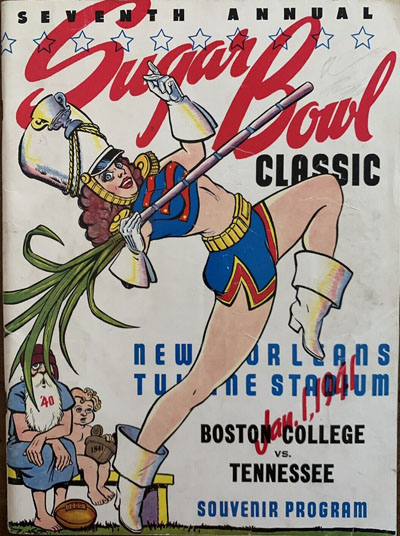
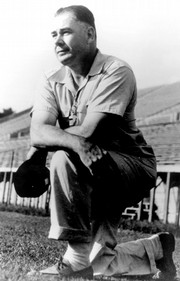
L-R: Frank Leahy, Game Program, Robert Neyland
Leahy wanted to avoid the mistakes he had made the previous year in the month leading up to the Cotton Bowl loss. That team practiced mostly indoors in December in Boston. Then he allowed the players to spend Christmas at their homes before departing for Texas. He also held two-a-day practices after reaching Dallas.
For the Sugar Bowl, the 42-man Boston College squad traveled South on a special train over a two-day period, stopping in Atlanta to workout at Georgia Tech's field. Instead of staying in New Orleans, Leahy chose a hotel in Bay St. Louis MS, with practices held at St. Stanislaus College in that town 68 miles from New Orleans.
As an example of the thoroughness of his preparation, Leahy ordered 400 gallons of Poland Spring Water to be brought on the trip. He didn't want any players to suffer any ill effects from the sulfur-tasting Southern tap water.
After a pair of double practice sessions after arriving in Mississippi, the BC contingent attended the Christmas Eve party for the teams in New Orleans. They returned to Bay St. Louis in the wee hours of the morning. To make sure his players knew this was a business trip, Leahy held a scrimmage Christmas afternoon.
On New Year's Eve, Leahy took his team to the Bay St. Louis High School gym and put in a secret play for the next day's game. He called it "Shift Right – Tennessee Special" because it was a carbon copy of one of the Vols' favorite plays, a run-pass option.
Tennessee was playing in its third bowl game in as many years. In contrast to Leahy, Coach Neyland checked his Vols into a downtown New Orleans hotel a few days before the game and let his players enjoy the sights of the famed French Quarter.
Featured Player
When Charlie O'Rourke tried to play high school football, he weighed only 122lbs. He had to fight his way onto the team and convince his coach that he could do the job.
When he went to Boston College, he had grown to 5'11" 175lb. Still, Coach Boston College took one look at him and said, "The fellow's too small. He will never play here."
Even Boston College, who succeeded Dobie when O'Rourke was a junior, thought Charlie was too small for the kind of football Leahy taught. But it didn't take Leahy long to realize that Charlie could fit right into the great team he was building because of his excellent passing and punting.
|
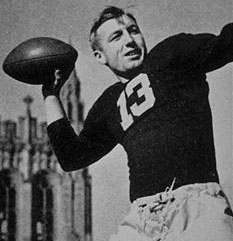 BC Sub Turri Yearbook 1941 |
During his three seasons of eligibility, O'Rourke completed 69 of 150 passes for 1,108y and 14 touchdowns.
The Chicago Bears took O'Rourke in the fifth round of the 1941 NFL Draft. He saw limited playing time behind the great Sid Luckman during the 1942 season. But after serving in the military in World War II, O'Rourke signed with the Los Angeles Dons of the new All-American Football Conference. He led that league in completion % (57.7) in 1946 as he threw for over 1200y in that season and the following one. His pro career ended with two seasons with the Baltimore Colts, during which he threw only 58 passes.
O'Rourke was inducted into the College Football Hall of Fame in 1972. | |
Vols Turned Away Once But Not Second Time
On an unseasonably warm day, a Sugar Bowl record crowd of 73,181 watched Sugar Bowl #7, the first one involving two undefeated teams, favored Tennessee dominate the first half but take only a 7-0 lead to the locker room.
Before the kickoff, Boston College's terrific blocking back, Tarzan Toczylowski, sought out the Tennessee captain and said: "We're just a bunch of Polish boys, whose fathers weren't even in America when your ancestors fought the Union. What I want to know is this: Do you want to fight the Civil War all over again today or just have a good, hard football game?"
The Vol captain couldn't suppress a smile. "Let's just settle for a football game," he replied. The contest that followed was one of the cleanest ever waged between a southern and norther team.
The first break went the Vols way when Bobby Foxx got off a beautiful punt to the Eagles' 20. Charlie O'Rourke fielded the ball but fumbled when hit, and Tennessee Captain Norbert Ackerman pounced on the ball at the BC 27.
Van Thompson crashed through left tackle for 11. But just when it looked like the Vols would score, incomplete passes turned the ball over to the Eagles on their 15.
O'Rourke punted out of bounds on the BC 46, and this time the Vols would not be denied. Thompson threw a pass to E Ed Ciphers that was broken up by O'Rourke. But he was called for interference to put the pigskin on the 32. E Jimmy Coleman snagged the next pass for 12y before reverses by Thompson and Foxx netted 11y to the 9.
Bill Nowling gained five on a fake reverse, then three more on a spinner play to put the pigskin on the four. Thompson took it in from there behind great blocking by T Abe Shires and All-American G Bob Suffridge. Foxx converted to make it 7-0 Tennessee.

BC's Mike Holovak tackles UT's Fred Newman (Tennessee Volunteer Yearbook Class of 1941)
After throwing an interception in Vol territory, BC got the ball back at their 20 after a beautiful punt by Foxx against the wind.
The Eagles drove from there to the UT 20. The key plays were O'Rourke's 13y gain around right end and his "bullet pass" to E Gene Goodreault for 26y to the Vol 33. O'Rourke gained nine off right tackle, and HB Frank Maznicki picked up three for another first down. But all this fine offensive work went for naught when E Ed Cifers intercepted O'Rourke's pass intended for Goodreault as the first quarter ended.
Vols Pitch First Half Shutout
The highlight of the scoreless second period was the punting of Johnny Butler and O'Rourke. Butler got off a quick-kick to the 19. That enabled the Vols to take over at their 48 after the subsequent punt back to them. Several runs and an offside penalty on BC moved the ball to the 24. But on third-and-three, O'Rourke saved the Eagles by picking off Warren's pass on the two as the half ended. Tennessee 7 Boston College 0
During the break, Coach Leahy learned that his star tailback O'Rourke was sick. So Leahy was reluctant to use him unless necessary. He held him out the entire third quarter but sent him onto the field in the fourth.
Blocked Punt Sets up Tying TD
Outplayed in the first half, BC made their own break to start the second half when E Hank Woronicz blocked Foxx's punt – UT's first blocked punt in seven years – and Joe Zabilski recovered on the UT 17. The Eagles scored in two plays to tie the game. Maznicki raced around left end for a 5y gain behind the blocking of BB Henry Toczylowski. "Tozz" threw another great block on the next play to help Mickey Connolly, O'Rourke's replacement at tailback, cover the final 12y around right end to the end zone. Maznicki's PAT kick tied the score at 7-7.
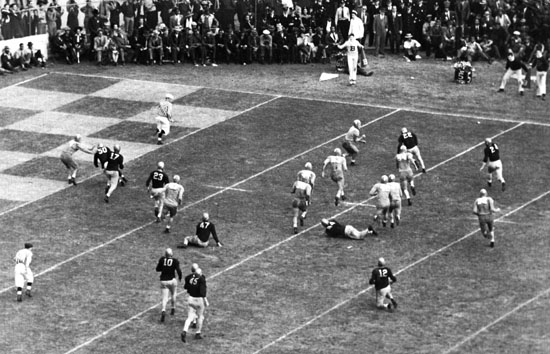
Henry Toczylowski (22) throws block to spring Mickey Connolly (24) to score for Boston College.
(https://twitter.com/BCFootball/status/809867197011152896)
Vols Retake Lead
Tennessee roared right back, moving 55 yards aided by a questionable pass interference penalty ("called by the Northern official" according to the New York Times). Chester Gladchuk, who purposely kicked out of bounds every time, got off a bad one that gave the Vols possession at their 45. Fine ball-carrying by Thompson and Fred Newman and a pass from Thompson to Cifers for 13y set the stage for the disputed play. Thompson threw the ball to Cifers that fell incomplete. But pass interference on Connolly put the ball on the two. Some observers thought the ball was uncatchable.
BC stuffed Newman up the middle on the first down play, but that only delayed the inevitable as Warren broke off left guard for the touchdown on the next snap. Neyland's teams always took pride in their kicking game, but the extra point pass from center was bad, causing Newman to run unsuccessfully for the PAT to keep the score at 13-7 Tennessee.
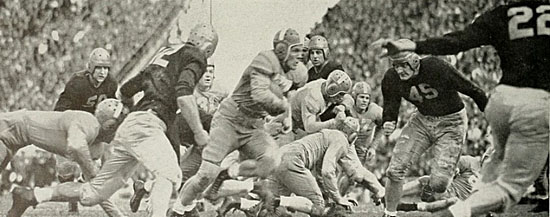
Bobby Foxx carries for Tennessee. (Boston College Sub Turri Yearbook Class of 1941)
Eagles Answer Back
BC retaliated with a 68 yard touchdown drive keyed by Connolly's 9y run that was followed by a 15y penalty on UT because a substitute made the mistake of talking to one of his teammates without waiting one play. Then Connolly connected with Fred Naumetz for 20y to the 22.
The onslaught continued as runs by Maznicki and Connolly placed the pigskin on the 10. After a gain of two, the Eagles tried "their famous spread" for the first time in the game. Connolly threw to Maznicki in the flat, and he ran behind two blockers to the two. On third down, FB Mike Holovak pushed forward to the 6-inch line. Then he took it again on fourth down for the touchdown. BC's attempt to run in the PAT failed, keeping the game tied at 13.
Several weeks before the game, Coach Leahy told the Boston Quarterback Club members at a luncheon: "I want to make one prediction about the Sugar Bowl game. It is that Boston College will outplay Tennessee in the last quarter." The statement didn't appear in the press anywhere in the South. If it had, chances are it would have been greeted with derision. For no team in the last three years had been able to wear out or outlast Tennessee in the last quarter. Leahy's Eagles would now get a chance to make the promise come true.
Tennessee started a drive that carried over to the fourth quarter. Two straight end arounds by Mike Balitsaris made it first and ten at the BC 38. Two more runs put the ball at the 17. Lester Lautenschlaeger, a great back on Tulane's undefeated 1925 team, thought the turning point of the game came on the next play. Butler dropped back to pass, and as he took his time looking for a receiver, he was hit from behind by T Steve Levanitis and fumbled. E Donald Currivan recovered for the Eagles. Levanitis was one of the second stringers that Leahy had counted on to beat the Vols in the last period.
"From the way I saw it," said Lautenschlaeger, "Butler could be running yet on that play. Boston players dropped back to take care of the receivers, and Butler had a big opening if he wanted to run, but the Vols were playing too mechanical-like. It was a pass play, and Butler wasn't going to do anything but pass. If he had taken advantage of the chance to run instead and gone on his own, I doubt if he could have been tackled from behind."
The defenses stabilized until Tennessee started a drive into BC territory. The big gain came when Foxx broke loose into thesecondary. BC LB Gladchuk tore up from behind and nailed Foxx with a tremendous touchdown-saving tackle. That proved to be crucial because the Vols' drive stalled at the seven. So Foxx tried a 25y field goal that bounced off the upright with six minutes left in the game to maintain the tie score.
O'Rourke Leads Winning Drive
BC then started a drive at its 20. O'Rourke, Maznicki, and Kissell took turns carrying the ball to gain a first down that gave O'Rourke more leeway to start passing. His first successful heave was to Eddie Zabilski to midfield. Then he found Zabilski twice more for gains of 19 and 7y to put the ball on Tennessee's 24 as rain started to fall. Zabilski had been a third-string end when the regular season ended.
Next came a play in which O'Rourke did what UT's Butler had not done when he couldn't find a receiver and was hit and fumbled. Leahy called for the secret play he taught the team in Bay St. Louis – "Shift Right – Tennessee Special."
O'Rourke took the snap and, running left, raised his arm as if to pass, causing the UT backs to drift that way. Instead, he tucked the ball away, cut back to the right, ran parallel to the line of scrimmage, ducked in and out of at least a half dozen pairs of clutching arms, and swivel-hipped down the sideline into the end zone. Afterwards Leahy revealed that he had seen Neyland's team use the play on film and added it to his playbook. Although the PAT failed, BC's defense held for the last two minutes for the win. Fittingly, the game ended with an O'Rourke interception.
FINAL SCORE: BOSTON COLLEGE 19 TENNESSEE 13
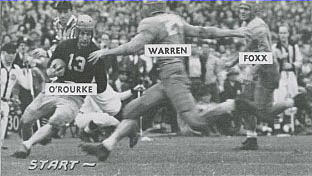
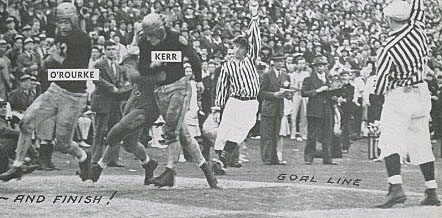
The start and finish of O'Rourke's winning touchdown run.
(Tennessee Volunteer Yearbook Class of 1941)
Postgame
A reporter for the Nashville Tennessean, Raymond Johnson, wrote that the Vols' defeat "could be traced to the fact that the Vols lost their poise. The Orangemen seemed to lose heart in the last period after they had been throttled twice on the threshold of a touchdown."
In his Boston Post article the next day, reporter Bill Cunningham called the Boston College season "the greatest Cinderella story in the history of American college football ..."
Leahy praised his squad. "This is the finest squad I've ever had. Their courage and character was the one thing that kept us going this season. I don't think I'll ever have a finer bunch of players as long as I am coaching. A coach usually has his pet team, and this one is mine. I don't see how any other could be better."
Coach Neyland had little to say. "Boston College had a better team today, and our coaching staff and players congratulate them on their victory."
To this day, Boston College calls itself 1940 National Champions. They argue that they should at least be considered co-champs with Minnesota and 10-0 Stanford, which beat Nebraska 21-13 in the Rose Bowl.
After returning home an ecstatic Leahy told the mayor of Boston, "I pledge and I guarantee that this is just the start of things. I told these lads at halftime that they were upholding the honor of dear old New England. ... I told them I would always be with them. ... I love Boston College, and I will never leave it. That is my pledge and my promise." He backed up his words by signing a contract extension.
But the only event that would tempt Boston College to renege on his pledge happened. The administration of his alma mater, Notre Dame, was dissatisfied with Elmer Layden (one of the famous Four Horsemen) in both his positions as head coach and athletic director. Notre Dame assistant coach Chet Grant traveled to the Sugar Bowl to scout Frank Leahy's team.
Grant's report said, "Boston College outsmarted, outcharged, outstayed probably the best team in the country in as well-played a game as ever I saw. Boston College showed me things I didn't think could be done. ... In short, the man (Leahy) has everything. Maybe the report sounds too good to be true, but remember, there was a Rockne once, why can't there be a Leahy?"
With Layden's five-year contract coming to an end, Notre Dame offered him only a one-year extension. Instead of accepting, he chose to become commissioner of the National Football League at a greater salary.
So just as Boston College fans looked forward to being the major football power in the East for many years, Leahy accepted the head coaching job for the 1941 season at his alma mater, where "The Master" would work for 11 years before retiring with a 107-13-9 cumulative record.
References
College Football U.S.A. 1869…1972: Official Book of the National Football Foundation (1972)
Shake Down the Thunder! The Official Biography of Notre Dame’s Frank Leahy, Wells Trombly (1974)
Neyland: The Gridiron General, Bob Gilbert (1990)
Shake Down the Thunder: The Creation of Notre Dame Football, Murray Sperber (1993)
Stadium Stories Tennessee Volunteers: Colorful Tales of the Orange and White, Randy Moore (2004)
Sugar Bowl Classic: A History, Marty Mulé (2008)
Tales from the Boston College Sideline: A Collection of the Greatest Eagles Stories Ever Told, Reid Oslin (2013)
College Football U.S.A. 1869…1972: Official Book of the National Football Foundation (1972)
Shake Down the Thunder! The Official Biography of Notre Dame’s Frank Leahy, Wells Trombly (1974)
Neyland: The Gridiron General, Bob Gilbert (1990)
Shake Down the Thunder: The Creation of Notre Dame Football, Murray Sperber (1993)
Stadium Stories Tennessee Volunteers: Colorful Tales of the Orange and White, Randy Moore (2004)
Sugar Bowl Classic: A History, Marty Mulé (2008)
Tales from the Boston College Sideline: A Collection of the Greatest Eagles Stories Ever Told, Reid Oslin (2013)